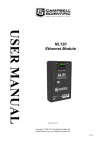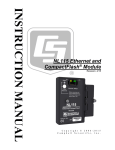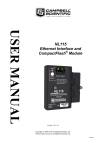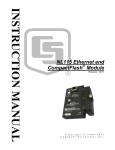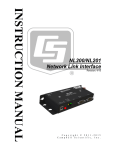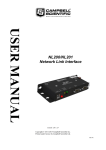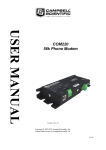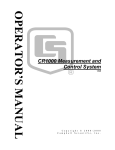Download Campbell NL120 Instruction manual
Transcript
INSTRUCTION MANUAL NL120 Ethernet Module Revision: 4/15 C o p y r i g h t © 2 0 0 6 - 2 0 1 5 C a m p b e l l S c i e n t i f i c , I n c . Limited Warranty “Products manufactured by CSI are warranted by CSI to be free from defects in materials and workmanship under normal use and service for twelve months from the date of shipment unless otherwise specified in the corresponding product manual. (Product manuals are available for review online at www.campbellsci.com.) Products not manufactured by CSI, but that are resold by CSI, are warranted only to the limits extended by the original manufacturer. Batteries, fine-wire thermocouples, desiccant, and other consumables have no warranty. CSI’s obligation under this warranty is limited to repairing or replacing (at CSI’s option) defective Products, which shall be the sole and exclusive remedy under this warranty. The Customer assumes all costs of removing, reinstalling, and shipping defective Products to CSI. CSI will return such Products by surface carrier prepaid within the continental United States of America. To all other locations, CSI will return such Products best way CIP (port of entry) per Incoterms ® 2010. This warranty shall not apply to any Products which have been subjected to modification, misuse, neglect, improper service, accidents of nature, or shipping damage. This warranty is in lieu of all other warranties, expressed or implied. The warranty for installation services performed by CSI such as programming to customer specifications, electrical connections to Products manufactured by CSI, and Product specific training, is part of CSI's product warranty. CSI EXPRESSLY DISCLAIMS AND EXCLUDES ANY IMPLIED WARRANTIES OF MERCHANTABILITY OR FITNESS FOR A PARTICULAR PURPOSE. CSI hereby disclaims, to the fullest extent allowed by applicable law, any and all warranties and conditions with respect to the Products, whether express, implied or statutory, other than those expressly provided herein.” Assistance Products may not be returned without prior authorization. The following contact information is for US and international customers residing in countries served by Campbell Scientific, Inc. directly. Affiliate companies handle repairs for customers within their territories. Please visit www.campbellsci.com to determine which Campbell Scientific company serves your country. To obtain a Returned Materials Authorization (RMA), contact CAMPBELL SCIENTIFIC, INC., phone (435) 227-9000. After an application engineer determines the nature of the problem, an RMA number will be issued. Please write this number clearly on the outside of the shipping container. Campbell Scientific’s shipping address is: CAMPBELL SCIENTIFIC, INC. RMA#_____ 815 West 1800 North Logan, Utah 84321-1784 For all returns, the customer must fill out a “Statement of Product Cleanliness and Decontamination” form and comply with the requirements specified in it. The form is available from our web site at www.campbellsci.com/repair. A completed form must be either emailed to [email protected] or faxed to (435) 227-9106. Campbell Scientific is unable to process any returns until we receive this form. If the form is not received within three days of product receipt or is incomplete, the product will be returned to the customer at the customer’s expense. Campbell Scientific reserves the right to refuse service on products that were exposed to contaminants that may cause health or safety concerns for our employees. Precautions DANGER — MANY HAZARDS ARE ASSOCIATED WITH INSTALLING, USING, MAINTAINING, AND WORKING ON OR AROUND TRIPODS, TOWERS, AND ANY ATTACHMENTS TO TRIPODS AND TOWERS SUCH AS SENSORS, CROSSARMS, ENCLOSURES, ANTENNAS, ETC. FAILURE TO PROPERLY AND COMPLETELY ASSEMBLE, INSTALL, OPERATE, USE, AND MAINTAIN TRIPODS, TOWERS, AND ATTACHMENTS, AND FAILURE TO HEED WARNINGS, INCREASES THE RISK OF DEATH, ACCIDENT, SERIOUS INJURY, PROPERTY DAMAGE, AND PRODUCT FAILURE. TAKE ALL REASONABLE PRECAUTIONS TO AVOID THESE HAZARDS. CHECK WITH YOUR ORGANIZATION'S SAFETY COORDINATOR (OR POLICY) FOR PROCEDURES AND REQUIRED PROTECTIVE EQUIPMENT PRIOR TO PERFORMING ANY WORK. Use tripods, towers, and attachments to tripods and towers only for purposes for which they are designed. Do not exceed design limits. Be familiar and comply with all instructions provided in product manuals. Manuals are available at www.campbellsci.com or by telephoning (435) 227-9000 (USA). You are responsible for conformance with governing codes and regulations, including safety regulations, and the integrity and location of structures or land to which towers, tripods, and any attachments are attached. Installation sites should be evaluated and approved by a qualified engineer. If questions or concerns arise regarding installation, use, or maintenance of tripods, towers, attachments, or electrical connections, consult with a licensed and qualified engineer or electrician. General • Prior to performing site or installation work, obtain required approvals and permits. Comply with all governing structure-height regulations, such as those of the FAA in the USA. • Use only qualified personnel for installation, use, and maintenance of tripods and towers, and any attachments to tripods and towers. The use of licensed and qualified contractors is highly recommended. • Read all applicable instructions carefully and understand procedures thoroughly before beginning work. • Wear a hardhat and eye protection, and take other appropriate safety precautions while working on or around tripods and towers. • Do not climb tripods or towers at any time, and prohibit climbing by other persons. Take reasonable precautions to secure tripod and tower sites from trespassers. • Use only manufacturer recommended parts, materials, and tools. Utility and Electrical • You can be killed or sustain serious bodily injury if the tripod, tower, or attachments you are installing, constructing, using, or maintaining, or a tool, stake, or anchor, come in contact with overhead or underground utility lines. • Maintain a distance of at least one-and-one-half times structure height, 20 feet, or the distance required by applicable law, whichever is greater, between overhead utility lines and the structure (tripod, tower, attachments, or tools). • Prior to performing site or installation work, inform all utility companies and have all underground utilities marked. • Comply with all electrical codes. Electrical equipment and related grounding devices should be installed by a licensed and qualified electrician. Elevated Work and Weather • Exercise extreme caution when performing elevated work. • Use appropriate equipment and safety practices. • During installation and maintenance, keep tower and tripod sites clear of un-trained or nonessential personnel. Take precautions to prevent elevated tools and objects from dropping. • Do not perform any work in inclement weather, including wind, rain, snow, lightning, etc. Maintenance • Periodically (at least yearly) check for wear and damage, including corrosion, stress cracks, frayed cables, loose cable clamps, cable tightness, etc. and take necessary corrective actions. • Periodically (at least yearly) check electrical ground connections. WHILE EVERY ATTEMPT IS MADE TO EMBODY THE HIGHEST DEGREE OF SAFETY IN ALL CAMPBELL SCIENTIFIC PRODUCTS, THE CUSTOMER ASSUMES ALL RISK FROM ANY INJURY RESULTING FROM IMPROPER INSTALLATION, USE, OR MAINTENANCE OF TRIPODS, TOWERS, OR ATTACHMENTS TO TRIPODS AND TOWERS SUCH AS SENSORS, CROSSARMS, ENCLOSURES, ANTENNAS, ETC. Table of Contents PDF viewers: These page numbers refer to the printed version of this document. Use the PDF reader bookmarks tab for links to specific sections. 1. Introduction ................................................................. 1 2. Cautionary Statements ............................................... 1 3. Initial Inspection ......................................................... 1 4. Quickstart .................................................................... 2 4.1 4.2 Physical Setup ...................................................................................... 2 Communicating via Ethernet ................................................................ 2 4.2.1 Step 1 – Configure Datalogger ...................................................... 2 4.2.2 Step 2 – LoggerNet Setup ............................................................. 3 4.2.3 Step 3 – Connect ........................................................................... 4 5. Specifications ............................................................. 4 6. TCP/IP Functionality ................................................... 5 6.1 6.2 6.3 6.4 6.5 6.6 6.7 6.8 6.9 Communicating over TCP/IP ............................................................... 6 6.1.1 Data Callback ................................................................................ 6 6.1.2 Datalogger-to-Datalogger Communication ................................... 7 HTTP Web Server ................................................................................ 7 FTP ....................................................................................................... 8 6.3.1 FTP Server .................................................................................... 8 6.3.1.1 Step 1 – Configure Datalogger ......................................... 10 6.3.1.2 Step 2 – Access File System............................................. 10 6.3.2 FTP Client ................................................................................... 10 Telnet ................................................................................................. 11 Ping .................................................................................................... 11 Serial Server ....................................................................................... 11 6.6.1 Serial Input .................................................................................. 11 6.6.2 Serial Output ............................................................................... 12 TCP ModBus...................................................................................... 12 DHCP ................................................................................................. 12 DNS.................................................................................................... 12 Figures 4-1. 4-2. 5-1. 6-1. 6-2. 6-3. NL120 attached to a CR1000 ............................................................... 2 LoggerNet setup ................................................................................... 4 NL120 Ethernet Module....................................................................... 5 Datalogger home page.......................................................................... 8 FTP root directory ................................................................................ 9 FTP USR directory............................................................................... 9 i NL120 Ethernet Module 1. Introduction Campbell Scientific’s NL120 Ethernet Module enables 10Base-T Ethernet communications. It allows the datalogger to communicate over a local network or a dedicated Internet connection via TCP/IP. This small, rugged communication device connects to the 40-pin peripheral port on a CR1000 or CR3000 datalogger. This manual describes how to use LoggerNet to connect to your datalogger with an NL120 attached. You can also use other software packages such as PC400, RTDAQ, or LoggerLink Mobile Apps for iOS and Android. Before using the NL120, please study: • • • Section 2, Cautionary Statements (p. 1) Section 3, Initial Inspection (p. 1) Section 4, Quickstart (p. 2) The Quickstart section explains how to quickly begin using an NL120 for straightforward Ethernet communications. Section 6 describes in detail the TCP/IP functionality of the NL120. 2. 3. Cautionary Statements • The NL120 is rugged, but it should be handled as a precision scientific instrument. • The 28033 Surge Suppressor and/or a shielded, 10Base-T Ethernet cable should be used for locations susceptible to power surges and for cable length longer than 9 ft. • Always power down the datalogger before installing or removing the NL120 to or from the datalogger. • The first time an NL120 is attached to a datalogger, the datalogger’s memory has to be reorganized to allow room in memory for the IP stack. To avoid the loss of data, collect your data before attaching the NL120 to a datalogger. Initial Inspection Upon receipt of the NL120, inspect the packaging and contents for damage. File damage claims with the shipping company. 1 NL120 Ethernet Module 4. Quickstart This section describes the basics of communicating via Ethernet with the NL120. 4.1 Physical Setup CAUTION Always power down the datalogger before installing or removing the NL120 to or from the datalogger. After powering down the datalogger, plug the NL120 into the datalogger peripheral port (see FIGURE 4-1). Attach Ethernet cable to the 10Base-T port. If using the 28033 Surge Protector, connect the other end of the Ethernet cable to the 28033 and connect another Ethernet cable to the other end of the 28033. Restore power to the datalogger. FIGURE 4-1. NL120 attached to a CR1000 4.2 Communicating via Ethernet 4.2.1 Step 1 – Configure Datalogger 2 a. Connect serial cable from PC COM port to datalogger RS-232 port. b. Open Campbell Scientific’s Device Configuration Utility. Select the device type of the datalogger (CR1000 or CR3000), the appropriate Serial Port, and baud rate. Connect to the datalogger. c. Under the TCP/IP tab, input the IP Address, Subnet Mask, and IP gateway. These values should be provided by your network administrator. NL120 Ethernet Module d. Press the Apply button to save the changes and then close the Device Configuration Utility. NOTE A temporary IP address may be obtained from a DHCP server. For more information, see Section 6.8, DHCP (p. 12). NOTE The NL120 must be connected to the datalogger before configuring the datalogger with the Device Configuration Utility. If it is not connected, the TCP/IP settings will not be displayed. 4.2.2 Step 2 – LoggerNet Setup The next step is to run LoggerNet and configure it to connect to the datalogger via the Ethernet port. a. In LoggerNet’s Setup Screen, press Add Root and choose IPPort. Input the datalogger’s IP address and port number. The IP address and port number are input on the same line and separated by a colon. (The datalogger’s default port number is 6785. It can be changed using Device Configuration Utility or by modifying its value in the Status Table.) b. Add a PakBus port and set the desired baud rate. c. Add the datalogger (CR1000 or CR3000). Input the PakBus address of the datalogger. 3 NL120 Ethernet Module FIGURE 4-2. LoggerNet setup 4.2.3 Step 3 – Connect You are now ready to connect to your datalogger using the LoggerNet Connect screen. Datalogger program transfer, table-data display, and data collection are now possible. 5. Specifications Datalogger Compatibility: CR1000, CR3000 Power Requirements: 12 V supplied through datalogger’s peripheral port Typical Current Drain: 20 mA (Note: To save power, the IPNetPower() instruction can be used to turn off power to the NL120. See the CRBasic help for an example of using the IPNetPower instruction.) Operating Temp. Range: –25 to 50 °C Standard –40 to 85 °C Extended EMI and ESD Protection: Meets requirements for a class-A device under European Standards Application of Council Directive(s): 89/336/EEC as amended by 89/336/EEC and 93/68/EEC Standards to which conformity is declared: EN55022-1: 1995 and EN50082-1: 1992 4 NL120 Ethernet Module Cable Requirements: NOTE Use a straight-through Ethernet cable when the cable is run from the hub to the NL120. Use a crossover Ethernet cable when the cable is run directly from the computer to the NL120. Use a shielded Ethernet cable and/or the 28033 surge suppressor when the cable length is greater than 9 ft. The maximum recommended segment length for 10BaseT networks using CAT5 cable is 100 meters. Segment length is the length of cable between the NL device and the Ethernet repeater, hub, switch, or router it is connected to. Ethernet Speed: 10Base-T (10 Mbps), half-duplex Software Requirements: LoggerNet 3.2 or later PC400 1.3 or later Dimensions: 10.2 x 6.4 x 2.8 cm (4.0 x 2.5 x 1.1 in) Weight: 66.6 g (2.35 oz) FIGURE 5-1. NL120 Ethernet Module 6. TCP/IP Functionality This section describes the main TCP/IP functionality of a datalogger with an NL120 attached. Additional functionality may be added in the future. For 5 NL120 Ethernet Module more information, refer to the Information Services section of the datalogger manual and CRBasic Editor Help. 6.1 Communicating over TCP/IP Once the datalogger, the NL120, and LoggerNet have been set up as described in Sections 4.1, Physical Setup (p. 2), and 4.2, Communicating via Ethernet (p. 2), communication is possible over TCP/IP. This includes program send and data collection. These are straightforward operations and are accomplished through LoggerNet’s Connect screen. For more information, see the LoggerNet manual. Data callback and datalogger-to-datalogger communications are also possible over TCP/IP, as well as the creation of simple HTML pages to view datalogger variables using a web browser. 6.1.1 Data Callback The following program is an example of doing data callback over TCP/IP. It first checks to see if a port to the LoggerNet Server already exists. (The LoggerNet Server is assumed to be at the default PakBus Address, 4094.) If not, a socket to LoggerNet is opened using the TCPOpen() instruction. The SendVariables() instruction is then used to send data. PROGRAM 'CR1000 'IP_Callback.cr1 'LoggerNet server Pak Bus Address assumed = 4094 'PC IP address assumed = 192.168.7.231 'LoggerNet IPPort "IP Port Used for Call-Back" = 6785 'LoggerNet IPPort "Call-Back Enabled" is checked 'LoggerNet CR1000 "Call-Back Enabled" is checked 'LoggerNet PakBusPort "PakBus Port Always Open" is checked 'IP Call-back using auto-discover (-1) neighbor in SetVariables Public PanelTemperature, BatteryVoltage, Result1, dummy1 Dim Socket as LONG DataTable (CLBK1,1,1000) DataInterval (0,0,Sec,10) Sample (1,PanelTemperature,FP2) Sample (1,BatteryVoltage,FP2) EndTable BeginProg Scan (5,Sec,6,0) PanelTemp (PanelTemperature,250) Battery (BatteryVoltage) If not Route(4094) then Socket = TCPOpen ("192.168.7.231",6785,0) SendVariables (Result1,Socket,-1,4094,0000,100,"Public","Callback",dummy1,1) CallTable CLBK1 NextScan EndProg 6 NL120 Ethernet Module 6.1.2 Datalogger-to-Datalogger Communication Communication between dataloggers is possible over TCP/IP. In order to do this, a socket must be opened between the two dataloggers. This is done using the TCPOpen() instruction. The socket opened by this instruction is then used by the instructions performing datalogger-to-datalogger communication. The example program below gets the battery voltage from a remote datalogger and sends its panel temperature to the remote datalogger. The remote datalogger is at IP address 192.168.7.125 and port 6785 is used for communication between the dataloggers. The remote datalogger must have its battery voltage stored in a public variable, BattVolt. It must also have a Public variable declared, PTemp_Base. This will be used to store the panel temperature of the base datalogger. PROGRAM 'CR1000 'DL-to-Dl_Comms_1.cr1 'Send this program to CR1000 #1 'Remote CR1000 #2 has PBA = 2, IP addr = 192.168.7.125, and port 6785 Public BattVolt,, BattVolt_Remote Public PTemp Public Result1, Result2 Dim Socket as LONG DataTable (Test,1,-1) DataInterval (0,12,Sec,10) Minimum (1,BattVolt,FP2,0,False) EndTable BeginProg Scan(2,Sec,0,0) Socket = TCPOpen(“192.168.7.125”,6785,0) BatteryVoltage(BattVolt) PanelTemp(PTemp,250) GetVariables (Result1,Socket,-1,2,0000,50,"Public","BattVolt",BattVolt_Remote,1) SendVariables (Result2,Socket,-1,2,0000,50,"Public","PTemp",PTemp_Base,1) CallTable(Test) NextScan EndProg 6.2 HTTP Web Server Typing the datalogger’s IP address into a web browser will bring up its home page as shown in FIGURE 6-1. This default home page provides links to the current record in all tables, including data tables, the Status table and the Public table. Clicking on a Newest Record link will bring up the latest record for that table. It will be automatically refreshed every 10 seconds. Links are also provided to the last 24 records in each data table. Clicking on a Last 24 Records link will bring up the last 24 records for that table. The Last 24 7 NL120 Ethernet Module Records Display must be manually refreshed. In addition, links are provided to all HTML files, all XML files, and all JPEG files in the datalogger. FIGURE 6-1. Datalogger home page If there is a default.html file on the datalogger, this will automatically become the user-configurable home page. The WebPageBegin/WebPageEnd declarations and the HTTPOut instruction can be used in a datalogger program to create HTML or XML files that can be viewed by the browser. For more information on using these instructions, see the datalogger manual or CRBasic Editor Help. NOTE 6.3 FileOpen() and FileWrite() can be used to create HTML pages, but this requires first writing the file to the datalogger’s USR drive. It is less convenient, and the page will be only as current as it is written to the file. FTP 6.3.1 FTP Server With an NL120 attached, the datalogger will automatically run an FTP server. This allows Windows Explorer to access the datalogger’s file system via FTP. In the FTP world, the “drives” on the datalogger are mapped into directories (or folders). The “root directory” on the datalogger will include CPU and possibly USR. The files will be contained in one of these directories. Files can be pasted and copied to/from the datalogger “drives” as if they were drives on the PC. Files on the datalogger drives can also be deleted through FTP. 8 NL120 Ethernet Module FIGURE 6-2. FTP root directory FIGURE 6-3. FTP USR directory 9 NL120 Ethernet Module In order to use FTP, the datalogger’s FTP User Name and FTP Password must be set. This is done using Device Configuration Utility. 6.3.1.1 Step 1 – Configure Datalogger NOTE a. Connect serial cable from PC COM port to datalogger RS-232 port. b. Open Campbell Scientific’s Device Configuration Utility. Select the device type of the datalogger (CR1000 or CR3000), the appropriate Serial Port, and baud rate. Connect to the datalogger. c. Under the Net Services tab, verify that FTP Enabled is checked. Input the FTP User Name and FTP Password. d. Press the Apply button to save the changes and then close the Device Configuration Utility. Using “anonymous” as the user name with no password allows FTP access without inputting a user name or password. 6.3.1.2 Step 2 – Access File System NOTE a. Datalogger must be set up for Ethernet communications as explained in Sections 4.1, Physical Setup (p. 2), and 4.2, Communicating via Ethernet (p. 2) (Step 1 only). b. Open a Windows Explorer window. Enter ftp://username:[email protected] where nnn.nnn.nnn.nnn is the IP address of the datalogger. If the user name is “anonymous” with no password, enter ftp://nnn.nnn.nnn.nnn where nnn.nnn.nnn.nnn is the IP address of the datalogger. 6.3.2 FTP Client The datalogger can also act as an FTP Client to send a file to or get a file from an FTP Server (for example, another datalogger or web camera). This is done using the FTPClient() instruction. The following program is an example of using FTPClient() to send a file to another datalogger and get a file from that datalogger. The first parameter in the instruction is the FTP Server’s IP address. The second parameter is the FTP username. The third parameter is the FTP password. The fourth parameter is the local filename. The fifth parameter is the remote file name. The final parameter is the put/get option: 0 for put and 1 for get. The instruction returns –1 if the instruction was successful and 0 if it was not. 10 NL120 Ethernet Module PROGRAM 'CR1000 'FTPClient.cr1 Public Result1, Result2 BeginProg Scan (20,Sec,1,1) Result1 = FTPClient("192.168.7.85","user","password","USR:pic.jpg","USR:pic.jpg",0) Result2 = FTPClient("192.168.7.85","user","password","USR:file.html”,"USR:file.html",1) NextScan EndProg 6.4 Telnet Telnetting to the datalogger’s IP address allows access to the same commands as the Terminal Emulator in LoggerNet Connect screen’s Datalogger menu. 6.5 Ping Pinging the datalogger’s IP address may be used to verify communication. 6.6 Serial Server With an NL120 attached, the datalogger can be configured to act as a serial server over the 10Base-T port. (A serial server is a device that allows serial communication over a TCP/IP port.) This function may be useful when communicating with a serial sensor over an Ethernet. 6.6.1 Serial Input The TCPOpen() instruction must be used first to open up a TCP socket. An example of this instruction is shown below. The first parameter in TCPOpen() is the IP address to open a socket to. “” means to listen on this port rather than connect. The second parameter is the port number to be used. The third parameter is buffer size. For a SerialIn() instruction that will use this connection, it gives a buffer size. The TCPOpen() instruction returns the socket number of the open connection or ‘0’ if it cannot open a connection. socket = TCPOpen(“”,6784,100) Once a socket has been opened with the TCPOpen() instruction, serial data may be received with a SerialIn() Instruction. An example of this instruction is shown below. The first parameter is the string variable into which the incoming serial data will be stored. The second parameter is the socket returned by the TCPOpen() instruction. The third parameter is the timeout. The fourth parameter is the termination character. The last parameter is the maximum number of characters to expect per input. For more information on this instruction, see the CRBasic Editor Help. SerialIn(Received,socket,0,13,100) 11 NL120 Ethernet Module 6.6.2 Serial Output The TCPOpen() instruction must be used first to open up a TCP socket. An example of this instruction is shown below. The first parameter in TCPOpen() is the IP address to open a socket to. The second parameter is the port number to be used. The third parameter is buffer size. The TCPOpen() instruction returns the socket number of the open connection or ‘0’ if it cannot open a connection. socket = TCPOpen(“192.168.7.85”,6784,100) Once a socket has been opened with the TCPOpen() instruction, serial data may be sent out with a SerialOut() instruction. An example of this instruction is shown below. The first parameter is the socket returned by the TCPOpen() instruction. The second parameter is the variable to be sent out. The third parameter is the wait string. The last parameter is the total number of times the datalogger should attempt to send the variable. For more information on this instruction, see the CRBasic Editor Help. result = SerialOut(socket,sent,"",0,100) 6.7 TCP ModBus With an NL120 attached, the datalogger can be set up as a TCP ModBus Master or Slave device. For information on configuring the datalogger as a TCP ModBus Master or Slave, see the ModBus section of the datalogger manual. 6.8 DHCP The IP address of the datalogger may be obtained through DHCP, if a DHCP server is available. The DHCP address will be automatically assigned if there is a DHCP server available and no static IP address has been entered. The IP address should be available a few minutes after the datalogger has been powered up with the NL120 attached and Ethernet cable plugged in. The IP address can be found with Device Configuration Utility’s Settings tab under TCP/IP info. It can also be found using a CR1000KD attached to the datalogger. Go to Configure, Settings | Settings, scroll down to IP Status and press the right arrow. An IP address obtained through DHCP is not static but is leased for a period of time set by the network administrator. The address may change, if the datalogger is powered down. 6.9 DNS The datalogger provides a DNS client that can query a DNS server to resolve a fully qualified domain name. When a DNS server is available, domain names can be used in place of the IP address in the datalogger instructions. 12 Campbell Scientific Companies Campbell Scientific, Inc. (CSI) 815 West 1800 North Logan, Utah 84321 UNITED STATES www.campbellsci.com • [email protected] Campbell Scientific Centro Caribe S.A. (CSCC) 300 N Cementerio, Edificio Breller Santo Domingo, Heredia 40305 COSTA RICA www.campbellsci.cc • [email protected] Campbell Scientific Africa Pty. Ltd. (CSAf) PO Box 2450 Somerset West 7129 SOUTH AFRICA www.csafrica.co.za • [email protected] Campbell Scientific Ltd. (CSL) Campbell Park 80 Hathern Road Shepshed, Loughborough LE12 9GX UNITED KINGDOM www.campbellsci.co.uk • [email protected] Campbell Scientific Australia Pty. Ltd. (CSA) PO Box 8108 Garbutt Post Shop QLD 4814 AUSTRALIA www.campbellsci.com.au • [email protected] Campbell Scientific Ltd. (CSL France) 3 Avenue de la Division Leclerc 92160 ANTONY FRANCE www.campbellsci.fr • [email protected] Campbell Scientific (Beijing) Co., Ltd. 8B16, Floor 8 Tower B, Hanwei Plaza 7 Guanghua Road Chaoyang, Beijing 100004 P.R. CHINA www.campbellsci.com • [email protected] Campbell Scientific Ltd. (CSL Germany) Fahrenheitstraße 13 28359 Bremen GERMANY www.campbellsci.de • [email protected] Campbell Scientific do Brasil Ltda. (CSB) Rua Apinagés, nbr. 2018 ─ Perdizes CEP: 01258-00 ─ São Paulo ─ SP BRASIL www.campbellsci.com.br • [email protected] Campbell Scientific Spain, S. L. (CSL Spain) Avda. Pompeu Fabra 7-9, local 1 08024 Barcelona SPAIN www.campbellsci.es • [email protected] Campbell Scientific Canada Corp. (CSC) 14532 – 131 Avenue NW Edmonton AB T5L 4X4 CANADA www.campbellsci.ca • [email protected] Please visit www.campbellsci.com to obtain contact information for your local US or international representative.






















